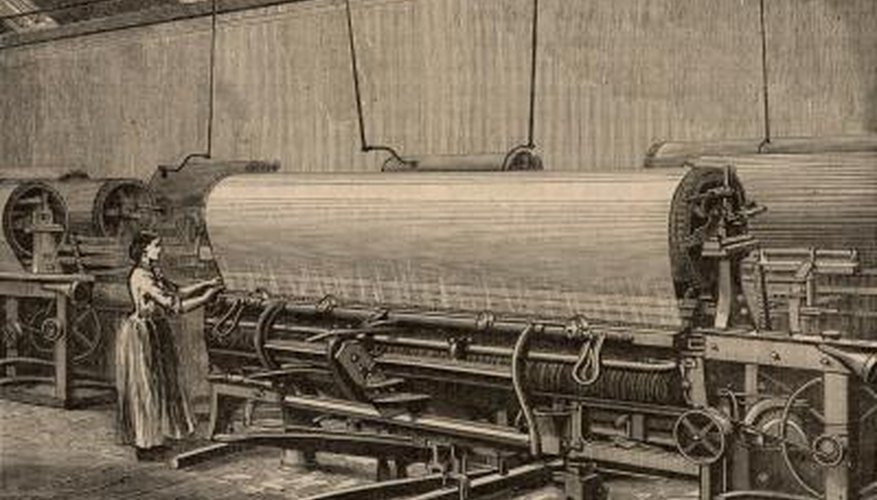The flying shuttle was one of the most important inventions of the early Industrial Revolution. Before its invention, weaving had mostly been a cottage industry done in small home workshops. After its invention, large factory looms began putting small-scale hand weavers out of business. The speed of the flying shuttle factory loom drove the invention of machine spinning, which in turn created a huge demand for cotton. Cotton cloth was really the first true industrial product, mass-produced cheaply in factories by machines rather than human craftsmen.
Invention of the Flying Shuttle
The flying shuttle was invented by John Kay, an Englishman, in 1733. Kay was seeking for a new kind of shuttle that would speed up the relatively slow pace of hand weaving. The role of the shuttle is to insert the weft between the warp threads on the loom. The warp threads run vertically from the front of the loom to the back, and the weaver raises some threads while lowering others. This creates the "shed," and the shuttle is thrown through the shed by the human hand, traditionally. On a traditional shuttle, the weft rolls off a bobbin in the shuttle and comes out one side of the shuttle. Kay invented a shuttle that was mechanically thrown. The weaver never touches the shuttle except to change the bobbin. This invention greatly sped up the weaving process and made it possible to weave much wider cloths. The new invention was controversial because it drove some hand weavers out of business. Kay never profited from his invention, and he died in France.
- The flying shuttle was invented by John Kay, an Englishman, in 1733.
- On a traditional shuttle, the weft rolls off a bobbin in the shuttle and comes out one side of the shuttle.
How the Flying Shuttle Works
The flying shuttle runs along a "race" that is built into the loom's beater. At each end of the race is a box with a mechanism in it for propelling the shuttle out of the box and across to the other side of the race, with great force. The weaver pulls on a cord that activates this mechanism and shoots the shuttle across the race. When the weaver pulls on the left side, the shuttle flies that way, and when he pulls right, it flies back. The flying shuttle has a bullet-shaped metal nose, and it runs across the race on rollers. The weft emerges from one end of the shuttle rather than from the side. The weft is wound onto a pirn rather than a bobbin, and the pirn does not rotate in the shuttle.
- The flying shuttle runs along a "race" that is built into the loom's beater.
- At each end of the race is a box with a mechanism in it for propelling the shuttle out of the box and across to the other side of the race, with great force.
Advantages of the Flying Shuttle
With a traditional shuttle, the rhythm of weaving involves several movements: the weaver opens the shed by stepping on the treadles, throws the shuttle with one hand, catches it with the other, and then uses the throwing hand to beat the weft in after closing the sheds. With the flying shuttle, the weaver's movements are minimised: he only has to change the sheds using his feet on the treadles, pull the cord and beat. His hands don't have to throw or catch the shuttle. Since the weaving width is no longer limited to the width of the weaver's reach, the fabric -- and the loom -- can be much wider than the reach of a man's arms.
- With a traditional shuttle, the rhythm of weaving involves several movements: the weaver opens the shed by stepping on the treadles, throws the shuttle with one hand, catches it with the other, and then uses the throwing hand to beat the weft in after closing the sheds.
- With the flying shuttle, the weaver's movements are minimised: he only has to change the sheds using his feet on the treadles, pull the cord and beat.
Disadvantages of the Flying Shuttle
The flying shuttle, like many other early inventions of the Industrial Revolution, came with a human cost. Weaving with it was much more tiring, as the race and boxes on the beater made the beater much heavier. In addition, rather than alternately beating with the left and right hand, the weaver would beat only with one hand for a long time and pull the cord with the other, which was a less ergonomically balanced way to weave. Also, the shuttle could fly out of the machine at great speed, and the factories where flying shuttles were used began to become dangerous places with accidents such as eye injuries. Eventually the flying shuttle was replaced by machines that injected the weft using other means.
- The flying shuttle, like many other early inventions of the Industrial Revolution, came with a human cost.
- Also, the shuttle could fly out of the machine at great speed, and the factories where flying shuttles were used began to become dangerous places with accidents such as eye injuries.
